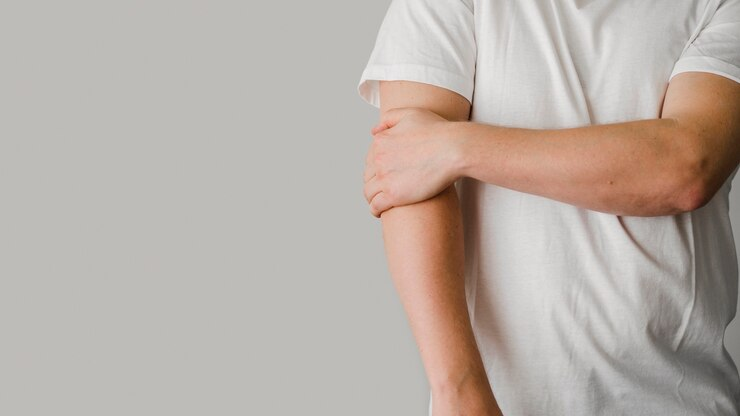Golfers Elbow Physiotherapy Treatment - Ultimate Guide
By Nigel ChuaPain in the bony bump on the inside of the elbow to the wrist could indicate medial epicondylitis, also known as golfer's elbow. This agonizing condition affects the tendons in the forearm muscles, causing discomfort and stiffness in the affected area. Among the many types of golf injuries, golfer's elbow is one of the most common. If you struggle with this medial elbow pain, experts suggest physical therapy as a good first treatment option.
In this comprehensive guide, we'll find out how physiotherapy management and a personalized treatment plan help with a golfer's elbow. But before diving in, let's grasp what a golfer's elbow is, its causes, and common symptoms. We'll also explore strategies for treating Golfer's Elbow, pain management, long-term healing, and identifying when surgical interventions may be necessary.

What is a Golfer's Elbow?
While this condition is commonly associated with the golf game due to the repetitive swinging motions, a golfer's elbow affects individuals beyond golf players.
Athletes, manual laborers, and people who frequently overwork their forearm muscles are susceptible to this condition. It can develop in anyone who engages in repetitive activities and motions that strain the forearm muscles and tendons.
A golfer's elbow develops gradually, causing pain and tenderness that may radiate down the forearm region, making the surrounding muscles immobile. In worse cases, this could lead to inflammation and tendon damage.
In Singapore, people age 40 or older have a higher risk of developing a golfer’s elbow. There are multiple treatment and pain relief methods, but if you're seeking a treatment plan that does not involve invasive surgery or injections, a physiotherapy top provider like Phoenix Rehab is your best option.
Specializing in bone, muscle, joint, and tendon pain recovery in Singapore, their physical therapists provide a range of services tailored to each client's needs, all without the discomfort and side effects associated with injections or surgical procedures.
What Causes a Golfer's Elbow?
The primary cause behind a golfer's elbow often springs from forearm muscle overuse, triggered by activities demanding intense, repetitive motions involving the fingers and hand. Tasks such as typing, engaging in racket sports, or labor-intensive manual work can lead to this condition. Other activities that cause it include the following:
- Throwing or gripping objects
- Shaking hands
- Heavy lifting
- Occupational movements (construction, carpentry, plumbing, etc.)
Specifically, actions requiring frequent wrist flexion or engaging in a forceful golf swing contribute to the strain placed on the tendons of the inner elbow.
The involvement of one or more fingers in these activities further worsens the stress on the wrist, amplifying the risk of developing a golfer's elbow.
Symptoms of Golfer's Elbow
Golfer's elbow manifests through various symptoms that signal its presence and progression. Primarily, patients experience localized pain on the inner side of the elbow, particularly during actions discussed above.
As you keep using the affected arm, the discomfort grows and can spread into your forearm, reflecting the strain on the tendons linked to the medial epicondyle. In later stages, this condition can disturb sleep, causing interrupted rest.
You might also feel pain or stiffness not just in your elbow but all along your arm, reaching up to your shoulder and neck. But as treatment advances and your tissues heal, these symptoms improve gradually, bringing back comfort and function to your shoulder, arm, and inner elbow.
Treating Golfer's Elbow and Pain Management
When experiencing symptoms of a golfer's elbow, immediately seek a proper diagnosis from a healthcare professional. A physical examination, along with possibly imaging tests, can help confirm the condition.
Once diagnosed, the focus shifts to the golfer's elbow physiotherapy treatment, which may include the following methods.
Manual Therapy
Trained physical therapists administer manual therapy as a crucial component of golfer's elbow treatment. This hands-on approach involves joint mobilization, manipulation, and soft tissue mobilization. The goal is to restore proper joint mechanics, reduce pain, and enhance range of motion. It also reduces muscle tension and improves tissue flexibility, aiding the healing process.
Massage Therapy
The main goal here is to alleviate muscle tension, improve blood flow in the arm, and reduce pain. Therapeutic deep massage techniques applied to the affected muscles and soft tissues can promote relaxation, enhance flexibility, and expedite the healing process.
Home Remedies
In addition to professional treatment modalities, certain home remedies can complement golfer's elbow management. Manage golfer's elbow pain at home through methods like applying ice packs to reduce inflammation, using over-the-counter pain relievers, and incorporating rest and elevation.
Supportive devices such as braces or splints can help prevent or reduce strain on the affected area during daily activities. Similarly, maintaining proper posture and positive lifestyle changes also help you recover faster from a golfer's elbow and even prevent recurrence.
Strengthening Exercises for Forearm Muscles
As part of the rehabilitation process of a golfer's elbow treatment, incorporate strengthening exercises that target the forearm muscles and promote proper wrist flexion. This will help you build arm strength and stability eventually. While performing these exercises, observe proper movement and form to avoid strains or triggers and ensure optimal recovery.

Additionally, eccentric exercises, which involve lengthening the muscle under tension, are particularly effective in promoting tendon healing and restoring muscle function. Examples include wrist flexion stretches and wrist curls with a focus on eccentric contraction and resistance.
Patient Post-Treatment Education
After completing treatment for the golfer's elbow, educating patients about post-treatment care and preventive measures is essential for maintaining long-term health and preventing recurrence. This includes self-management and injury prevention techniques, such as warming up before physical activity, using proper equipment and posture during sports or manual labor, and taking frequent breaks to rest and stretch during repetitive tasks.
More importantly, patients learn to monitor their symptoms closely, seek medical attention if they experience any recurrence or worsening of symptoms, and know when to follow up with their healthcare provider for further evaluation or treatment.
What to Avoid to Prevent the Recurrence of Golfer's Elbow
To prevent the golfer's elbow from recurring, address the underlying causes that led to it in the first place. These can vary in patients, but improper movements and technique during activities are usually the culprits. By practicing appropriate movement patterns and incorporating stretching and strengthening exercises into your daily routine, you can reduce the risk of developing this painful condition in the future.
Long-term management involves maintaining a balance between rest, exercise, and proper ergonomics to support overall elbow health.
When Surgery is Needed
While most cases of golfer's elbow can be effectively managed with conservative treatments like physiotherapy, in severe cases where symptoms persist despite intervention, surgery may be considered. Surgical options aim to repair damaged tendons and restore function in the affected region, providing relief for individuals who have not responded to non-invasive treatments.
Browse other articles by category
Physiotherapy for Knee Pain Physiotherapy For Slipped Disc Physiotherapy for Neck Pain PHYSIOTHERAPY
PHYSIOTHERAPY
 Hand Therapy
Hand Therapy
 Alternative
Alternative
 Massage
Massage
 Traditional Chinese Medicine Treatment
Traditional Chinese Medicine Treatment
 Rehab
Rehab
 Physiotherapy For Lower Back Pain
Physiotherapy For Shoulder Pain
Orthopedic Doctors, Insurance & Healthcare
Physiotherapy For Upper Back Pain
Frozen Shoulder
Physiotherapy for Back Pain
Physiotherapy For Lower Back Pain
Physiotherapy For Shoulder Pain
Orthopedic Doctors, Insurance & Healthcare
Physiotherapy For Upper Back Pain
Frozen Shoulder
Physiotherapy for Back Pain

 Whatsapp us now
Whatsapp us now